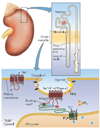The Na-K-ATPase and calcium-signaling microdomains
- PMID: 18697994
- PMCID: PMC5375021
- DOI: 10.1152/physiol.00008.2008
The Na-K-ATPase and calcium-signaling microdomains
Abstract
The Na-K-ATPase is an energy-transducing ion pump that converts the free energy of ATP into transmembrane ion gradients. It also serves as a functional receptor for cardiotonic steroids such as ouabain and digoxin. Binding of ouabain to the Na-K-ATPase can activate calcium signaling in a cell-specific manner. The exquisite calcium modulation via the Na-K-ATPase is achieved by the ability of the pump to integrate signals from numerous protein and non-protein molecules, including ion transporters, channels, protein kinases/phosphatases, as well as cellular Na+. This review focuses on the unique properties of the Na-K-ATPase and its role in the formation of different calcium-signaling microdomains.
Figures
References
-
- Akera T, Larsen FS, Brody TM. Correlation of cardiac sodium- and potassium-activated adenosine triphosphatase activity with ouabain-induced inotropic stimulation. J Pharmacol Exp Ther. 1970;173:145–151. - PubMed
-
- Anderson RG. The caveolae membrane system. Annu Rev Biochem. 1998;67:199–225. - PubMed
-
- Ando H, Mizutani A, Matsu-ura T, Mikoshiba K. IRBIT, a novel inositol 1,4,5-trisphosphate (IP3) receptor-binding protein, is released from the IP3 receptor upon IP3 binding to the receptor. J Biol Chem. 2003;278:10602–10612. - PubMed
-
- Aperia A. New roles for an old enzyme: Na,K-ATPase emerges as an interesting drug target. J Intern Med. 2007;261:44–52. - PubMed
Publication types
MeSH terms
Substances
Grants and funding
LinkOut - more resources
Full Text Sources
Other Literature Sources


